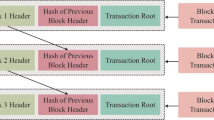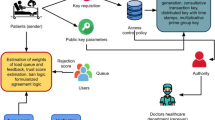Abstract
Health monitoring systems are improving with the development of the internet of things. This paper proposes a secure architecture consisting of a four-layer internet of things enabled health monitoring system that collects patient data and classifies them into different medical categories. While collecting patient information from their wearable smart sensing devices for computation, the privacy and security of this process are essential. The main motive of this paper is to develop a lightweight and secure communication protocol using blockchain architecture for decentralized IoT networks and classify them into different categories using transfer learning. We propose a framework that uses blockchain for security and incorporates transfer learning to use multiple pre-trained models. The proposed routing technique uses factors like probability, credibility rating, and node energy to route the data to its destination such that the network overhead is reduced and the energy used is minimal. We classify the collected patient information using four different pre-trained convolutional neural network models: ResNet50, VGG19, InceptionV3, and SqueezeNet. We simulate the proposed routing approach and other benchmark schemes on various performance metrics. The results show that the proposed approach gives 92.24% classification accuracy.














Similar content being viewed by others
Data availability
The datasets generated during and/or analyzed during the current study are available from the corresponding author on reasonable request. For more details on dataset, please refer to the paper [13].
References
Becker VD, Vahdat A (2000) Epidemic routing for partially connected ad hoc networks. In: Proceedings of technique report. Department of Computer Science, Duke University, Durham, UK
Chamarajnagar R, Ashok A (2018) Opportunistic mobile IoT with blockchain based collaboration. In: 2018 IEEE Global Communications Conference (GLOBECOM). IEEE, pp 1–6
Deng J, Dong W, Socher R, Li LJ, Li K, Fei-Fei L (2009) Imagenet: A large-scale hierarchical image database. In: 2009 IEEE Conference on Computer Vision and Pattern Recognition. pp 248–255. https://doi.org/10.1109/CVPR.2009.5206848
Dorri A, Kanhere SS, Jurdak R (2017a) Towards an optimized blockchain for IoT. In: 2017 IEEE/ACM Second International Conference on Internet-of-Things Design and Implementation (IoTDI). IEEE, pp 173–178
Dorri A, Kanhere SS, Jurdak R, Gauravaram P (2017b) Blockchain for IoT security and privacy: The case study of a smart home. In: 2017 IEEE International Conference on Pervasive Computing and Communications Workshops (PerCom Workshops). IEEE, pp 618–623
Dorri A, Kanhere SS, Jurdak R, Gauravaram P (2019) LSB: a lightweight scalable blockchain for IoT security and anonymity. J Parallel Distrib Comput 134:180–197
Faruk MJH, Shahriar H, Valero M, Sneha S, Ahamed SI, Rahman M (2021) Towards blockchain-based secure data management for remote patient monitoring. In: 2021 IEEE International Conference on Digital Health (ICDH). IEEE, pp 299–308
Fotiou N, Pittaras I, Siris VA, Polyzos GC (2019) Enabling opportunistic users in multi-tenant IoT systems using decentralized identifiers and permissioned blockchains. In: Proceedings of the 2nd international ACM workshop on security and privacy for the Internet-of-Things, pp 22–23
Hameed K, Garg S, Amin MB, Kang B (2021) A formally verified blockchain-based decentralised authentication scheme for the internet of things. J Supercomput 77(12):14461–14501
He K, Zhang X, Ren S, Sun J (2016) Deep residual learning for image recognition. In: Proceedings of the IEEE Conference on Computer Vision and Pattern Recognition, pp 770–778
Iandola FN, Han S, Moskewicz MW, Ashraf K, Dally WJ, Keutzer K (2016) Squeezenet: Alexnet-level accuracy with 50x fewer parameters and \(< 0.5\) mb model size. arXiv:1602.07360
Kazmi HSZ, Nazeer F, Mubarak S, Hameed S, Basharat A, Javaid N (2019) Trusted remote patient monitoring using blockchain-based smart contracts. In: International Conference on Broadband and Wireless Computing. Springer, Communication and Applications, pp 765–776
Khamparia A, Singh PK, Rani P, Samanta D, Khanna A, Bhushan B (2021) An internet of health things-driven deep learning framework for detection and classification of skin cancer using transfer learning. Trans Emerg Telecommun Technol 32(7):e3963
Khanna A, Rani P, Sheikh TH, Gupta D, Kansal V, Rodrigues JJ (2021) Blockchain-based security enhancement and spectrum sensing in cognitive radio network. Wirel Pers Commun pp 1–23
Lindgren A, Doria A, Schelén O (2003) Probabilistic routing in intermittently connected networks. ACM SIGMOBILE Mob Comput Commun Rev 7(3):19–20
Loreti P, Bracciale L (2019) Optimized neighbor discovery for opportunistic networks of energy constrained IoT devices. IEEE Trans Mob Comput 19(6):1387–1400
Mohanty SN, Ramya K, Rani SS, Gupta D, Shankar K, Lakshmanaprabu S, Khanna A (2020) An efficient lightweight integrated blockchain (ELIB) model for IoT security and privacy. Futur Gener Comput Syst 102:1027–1037
Pan J, Wang J, Hester A, Alqerm I, Liu Y, Zhao Y (2018) EdgeChain: an edge-IoT framework and prototype based on blockchain and smart contracts. IEEE Internet Things J 6(3):4719–4732
Ramezan G, Leung C (2018) A blockchain-based contractual routing protocol for the Internet of Things using smart contracts. Wirel Commun Mob Comput 2018
Rani P, Bhambay R (2022) A comparative survey of consensus algorithms based on proof-of-work. In: 3rd International Conference on Emerging Technologies in Data Mining and Information Security. Springer
Rani P, Balyan A, Jain V, Sangwan D, Singh PP, Shokeen J (2020) A probabilistic routing-based secure approach for opportunistic IoT network using blockchain. In: 2020 IEEE 17th India Council International Conference (INDICON). IEEE, pp 1–7
Rani P, Jain V, Joshi M, Khandelwal M, Rao S (2021a) A secured supply chain network for route optimization and product traceability using blockchain in internet of things. In: Data analytics and management. Springer, pp 637–647
Rani P, Singh PP, Balyan A, Shokeen J, Jain V, Sangwan D (2021b) A secure epidemic routing using blockchain in opportunistic internet of things. In: Data analytics and management. Springer, pp 101–110
Rathore S, Kwon BW, Park JH (2019) BlockSecIoTNet: blockchain-based decentralized security architecture for IoT network. J Netw Comput Appl 143:167–177
Rathore S, Pan Y, Park JH (2019) BlockDeepNet: a blockchain-based secure deep learning for IoT network. Sustainability 11(14):3974
Simonyan K, Zisserman A (2014) Very deep convolutional networks for large-scale image recognition. arXiv:1409.1556
Sujitha B, Parvathy VS, Lydia EL, Rani P, Polkowski Z, Shankar K (2021) Optimal deep learning based image compression technique for data transmission on industrial internet of things applications. Trans Emerg Telecommun Technol 32(7):e3976
Sun Y, Zhang L, Feng G, Yang B, Cao B, Imran MA (2019) Blockchain-enabled wireless Internet of Things: performance analysis and optimal communication node deployment. IEEE Internet Things J 6(3):5791–5802
Szegedy C, Vanhoucke V, Ioffe S, Shlens J, Wojna Z (2016) Rethinking the inception architecture for computer vision. In: Proceedings of the IEEE Conference on Computer Vision and Pattern Recognition, pp 2818–2826
Tschandl P, Rosendahl C, Kittler H (2018) The ham 10,000 dataset, a large collection of multi-source dermatoscopic images of common pigmented skin lesions. Sci Data 5(1):1–9
Waheed U, Khan MSA, Awan SM, Khan MA, Mansoor Y (2019) Decentralized approach to secure IoT based networks using blockchain technology. 3C Tecnología Glosas de innovación aplicadas a la pyme pp 182–205
Xie J, Tang H, Huang T, Yu FR, Xie R, Liu J, Liu Y (2019) A survey of blockchain technology applied to smart cities: research issues and challenges. IEEE Commun Surv Tutor 21(3):2794–2830
Yang R, Yu FR, Si P, Yang Z, Zhang Y (2019) Integrated blockchain and edge computing systems: a survey, some research issues and challenges. IEEE Commun Surv Tutor 21(2):1508–1532
Acknowledgements
This research did not receive any specific grant from funding agencies in the commercial, public, or non-profit sectors.
Author information
Authors and Affiliations
Corresponding author
Ethics declarations
Conflict of interest
The authors declare that they have no conflict of interest.
Additional information
Publisher's Note
Springer Nature remains neutral with regard to jurisdictional claims in published maps and institutional affiliations.
Rights and permissions
About this article
Cite this article
Rani, P., Kaur, P., Jain, V. et al. Blockchain-based IoT enabled health monitoring system. J Supercomput 78, 17284–17308 (2022). https://doi.org/10.1007/s11227-022-04584-3
Accepted:
Published:
Issue Date:
DOI: https://doi.org/10.1007/s11227-022-04584-3




